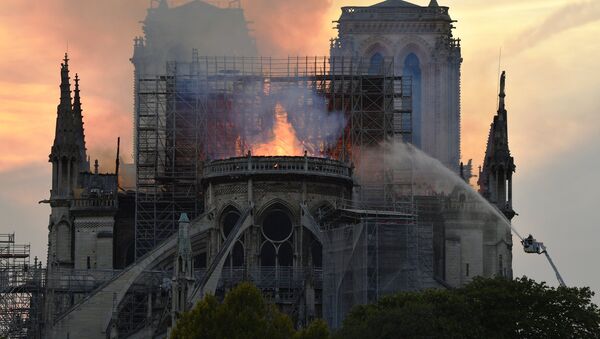The fire, which raged for nine hours, is believed to be linked to renovation work which was under way at the time.
York Minster, England 1984
In the early hours of 9 July 1984 a bolt of lightning set fire to York Minster, starting a fire which caused more than £2 million worth of damage.
The blaze destroyed the roof of the south transept of the 15th century Gothic cathedral.
— Dan Snow (@thehistoryguy) 15 April 2019
The intense heat cracked the stained glass Rose Window into tens of thousands of pieces.
But work soon began on restoring the minster, the home church of the Archbishop of York, and it was completed in 1988.
National Museum, Rio de Janeiro, 2018
On the night of 2 September 2018, Brazil's National Museum, near Rio de Janeiro, was hit by a huge fire.
Latin America's largest natural history and anthropology museum was home to 20 million artefacts.
The museum's paleontology department alone contained 26,000 fossils, including sabre-toothed tigers, giant sloths and a dinosaur skeleton from Minas Gerais state.
In February it was reported that a team working nine hours a day, six days a week had recovered 2,000 items, including remains of Brazilian indigenous arrows, a Peruvian vase, a pre-Columbian funeral urn and the 11,500-year-old skull of Luzia, the oldest human skeleton ever found in the Americas.
St Paul's Cathedral, London 1666
The original St Paul's Cathedral was a major landmark in medieval London.
But in September 1666 a great conflagration broke out in a bakery in Pudding Lane and spread across the city — the Great Fire of London.
St Paul's — which was actually the fourth cathedral to stand on the site — had been finished in 1314 but it could not withstand the flames which reached it on the third day of the fire and soon devoured it.
The roof melted, sending streams of molten lead "glowing with fiery redness" pouring down Ludgate Hill.
— The Boys of Paul Street (@amasya3535) 16 April 2019
The Church of England decided to commission Sir Christopher Wren, a brilliant scientist and mathematician and Britain's most famous architect, to design a new cathedral.
"The building he designed to replace the pre-fire Cathedral is his masterpiece. Nine years of planning were required to ensure that the new design would meet the requirements of a working cathedral. The quire was to be the main focus for liturgical activity, a Morning Chapel was required for Morning Prayer, vestries were needed for the clergy to robe, a treasury for the church plate, a home had to be planned for the enormous organ, bell towers were essential, and the interior had to be fitted for the grandest of occasions and ceremonies. The building which Wren delivered in thirty five years fulfilled all these needs and provided a symbol for the Church of England, the renewed capital city, and the emerging empire," says the St Paul's Cathedral website.
La Fenice, Venice, 1996
In 1996 the La Fenice opera house in Venice was gutted by fire.
La Fenice — which means The Phoenix in Italian — suffered three fires in the 18th and 19th centuries and was said to have among the best acoustics in the world.
Two electricians were convicted of negligence and jailed for a total of 13 years.
La Fenice reopened in 2004 after an extensive renovation.
Windsor Castle, England, 1992
Windsor Castle is one of the British Royal Family's main residence and on 20 November 1992, it caught fire, destroying the Queen's weekend residence.
Nine rooms were destroyed by the fire, which started in the former Chapel Royal when a lighting projector too close to a curtain started the blaze.
More than 200 firefighters spent 15 hours bringing the blaze under control.
The Castle reopened to the public in 1997 after five years of restoration, which cost British taxpayers £36 million.
As part of the deal with the UK government, the Queen agreed to pay income tax from 1993, becoming the first monarch to do so.
MGM Grand, Las Vegas, 1980
Around 5,000 guests were staying the MGM Grand hotel and casino complex on The Strip in Las Vegas when the fire broke out on the morning of 21 November 1980.
At 7.05am an employee noticed a fire in the kitchen of the delicatessen on the casino floor.
A 911 call was made and when Captain Rex Smith and a crew from the fire department arrived they noticed "heavy black smoke lying motionless in the atmosphere" above the casino pit.
Suddenly a fireball exploded out into the restaurant area and the firefighters began evacuating the hotel.
But many guests in the 26 storey hotel were still in their beds and soon became trapped.
The fire department's ladders were unable to reach the top floors and 87 people were to die, mainly from smoke inhalation.
The hotel was later sold and renamed Bally's casino, which it remains.
An entirely new MGM Grand was built 200 yards away and has since hosted some of the world's biggest boxing matches and other events.
National Library, Sarajevo, 1992
Bosnia's 19th century National Library was destroyed in the war-time siege of the city of Sarajevo, overnight on 25-26 August 1992.
It had housed some two million books, old scripts, photographs and transcripts before it was shelled by Serb forces who kept Sarajevo under a three-and-a-half-year long siege.
Only some 10 percent of its resources were saved from the resulting fire.
Reconstruction works, part-financed by the European Union, began in 1996 and the new library was inaugurated in 2014.
Grand Theatre, Geneva 1951
In 1951 the Grand Theatre of Geneva in Switzerland, built in the 19th century, was devastated in a fire that began during the preparation for a performance of Richard Wagner's "The Valkyrie".
It reopened in 1962.




